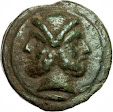 |
| Pecunem Auction 6 Lot 329, my coin, see description below |
 |
| BM449.4.1 |
 |
| BM449.4.2 |
 |
| BM449.4.3 |
 |
| BM449.4.4 |
 |
| BM449.4.5 |
 |
| BM449.4.6 |
 |
| Cr449.4.6 NAC A63 L351 |
C. VIBIUS C. F. CN.
PANSA CAETRONIANUS. Denarius (48 BC). Rome. Obv: LIBERTATIS. Laureate head of
Libertas right. Rev: C PANSA C F C N. Roma seated right on pile of arms, her
left foot on globe, holding sceptre and sword; in upper right field, Victory
flying left to crown her. Note the Macedonian helmet beneath the shields. I
found only one other coin picture with the helmet, BM online 449.4.5, and it
looks to me to be the same die. Does make coin a rare type?
Crawford 449/4
(Crawford estimates 33 obverse dies for this issue.); Grueber 3983; Sear 423;
RSC Vibia 20; Sydenham 949; CRI 23
Condition: Near
extremely fine; Weight: 4.0 g.; Pecunem Auction 6 Lot 329 Aug 4, 2013
The coin was minted in Rome by C. Vibius C.f.
C.n. Pansa Caetronianus , adoptive son of C. Vibius Pansa , a monetary triumvir
who worked during the years of the social war. He was elected tribune of the
plebs in 51 B.C. and supported Julius Caesar who sent him as a legate (general
officer) to the Gallia Cisalpina between 44 and 45 B.C. After his return and
after Caesar’s death, he was elected consul together with A. Hirtius (another
legate loyal to Caesar). In 43 B.C. helped Decimio Bruto in the campaign in
Modena against Marco Antonio. He died together with A. Hirtius during the
battle.
This coin was minted between 49 and 48 B.C., during the civil war between Caesar and Pompeo which ended with the battle of Farsalo and the defeat of Pompeo in Egypt. The virtus is represented here by Libertas – identified by the key LIBERTATIS- and by the figure of Rome on the other side of the coin. This is a clear reference to the propaganda of respect for the republican legality of Caesar.
This coin was minted between 49 and 48 B.C., during the civil war between Caesar and Pompeo which ended with the battle of Farsalo and the defeat of Pompeo in Egypt. The virtus is represented here by Libertas – identified by the key LIBERTATIS- and by the figure of Rome on the other side of the coin. This is a clear reference to the propaganda of respect for the republican legality of Caesar.











